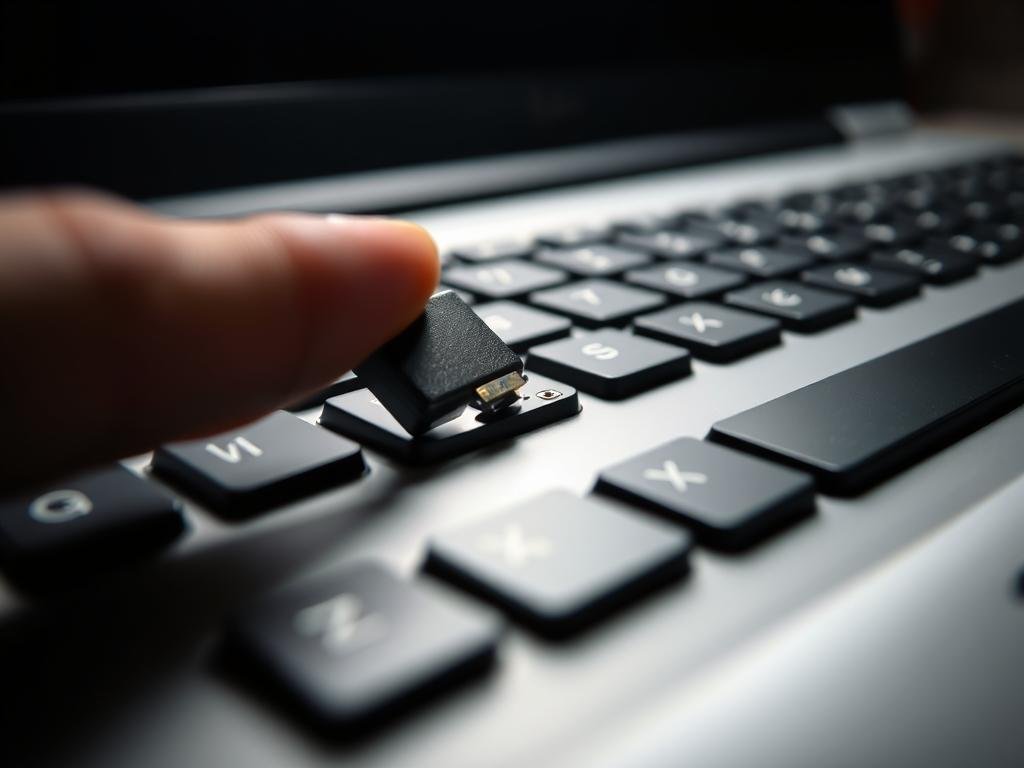Did you know many laptop users face keyboard problems? Asurion says a lot of people have issues with their laptop keyboard. These can be from software bugs to hardware failures.
If your keyboard isn’t working right, you’re in good company. Luckily, most problems can be fixed with simple steps. We’ll show you how to fix laptop keyboard issues and make your laptop work again.
Key Takeaways
- Common causes of laptop keyboard issues
- Basic troubleshooting steps to resolve keyboard problems
- Methods to repair or replace a faulty laptop keyboard
- Tips to prevent future keyboard issues
- When to seek professional help for keyboard repair
Common Issues with Laptop Keyboards
Laptop keyboards are key to using your device. But when they don’t work right, it’s really annoying. Issues like keys not working or typing the wrong thing are common. Knowing what these problems are is the first step to fixing them.
Unresponsive Keys
Keys that don’t work can really slow you down. This might be because of hardware or software problems. It could be dust under the keys, a bad keyboard controller, or old drivers.
Sticky or Jammed Keys
Keys that stick or get jammed are another big problem. This usually happens because of spills, dust, or debris under the keys. It can make keys get stuck or not work right.
Incorrect Key Inputs
When your keyboard types the wrong thing, it’s a big issue. This might be because of language setting problems, the wrong keyboard layout, or malware.
Figuring out why these problems happen is key to fixing them. Next, we’ll look at how to troubleshoot and possibly fix these common laptop keyboard issues.
Troubleshooting Your Laptop Keyboard
If your laptop keyboard isn’t working right, don’t worry. There are ways to fix it. Troubleshooting is easy and can help you find and solve the problem.
Check the Connection
First, make sure the keyboard is connected to your laptop. For most laptops, this means checking if it’s attached to the motherboard. If you’re okay with opening your laptop, you can check this. But if you’re not sure, it’s safer to ask a pro.
“A loose connection can often be the culprit behind a malfunctioning keyboard,” says a leading laptop repair technician. “Checking the connection is a simple yet effective first step in troubleshooting.”
Restart Your Laptop
At times, just restarting your laptop can solve the problem. Restarting can refresh your system and fix any software glitches that might be causing the keyboard trouble.
- Save any open work and close all applications.
- Restart your laptop.
- Test your keyboard after the restart.
Update Keyboard Drivers
Old or damaged keyboard drivers can also cause problems. To update your drivers, follow these steps:
- Go to your laptop manufacturer’s website and search for the latest keyboard drivers.
- Download and install the updated drivers.
- Restart your laptop to apply the changes.
Updating your keyboard drivers can often fix issues like wrong key inputs or unresponsive keys. As Microsoft support suggests, “Keeping your drivers up to date is key for your hardware to work smoothly.”

By trying these initial steps, you can often find and fix your laptop keyboard problem. If it doesn’t work, you might need to do more to figure out what’s wrong.
Cleaning Your Laptop Keyboard
Cleaning your laptop keyboard is easy and keeps it working well. Dust, dirt, and spills can make keys sticky or unresponsive. Cleaning regularly helps keep your keyboard in good shape.
Tools Needed for Cleaning
First, get the right tools. You’ll need a soft cloth, compressed air, and a disinfectant wipe. A keycap puller is good for deeper cleaning, but be careful not to harm the keys.
Step-by-Step Cleaning Process
To clean your laptop keyboard well, follow these steps:
- Turn off your laptop and unplug it from the power source.
- Use compressed air to gently blow away dust and debris from between the keys.
- Dampen a soft cloth with water, but make sure it’s not soaking wet. Gently wipe down the keys.
- For tougher stains or dirt buildup, use a disinfectant wipe, but avoid getting any liquids between the keys.
- If necessary, remove keycaps using a keycap puller to clean underneath. Be sure to reattach them securely afterward.
For more detailed instructions, you can refer to this guide on how to clean your laptop keyboard.
Experts say, “Regular maintenance is key to preventing keyboard issues.” Cleaning regularly boosts your keyboard’s performance and typing experience.
Conducting a Keyboard Test
A keyboard test can help find problems with your laptop keyboard. It ensures you fix it right. This test is key to figuring out if it’s a hardware or software issue.

Using Built-in Diagnostic Tools
Many laptops have built-in tools to test the keyboard. To use them, restart your laptop and press a key shown on the screen. In diagnostic mode, go to the keyboard test and follow the instructions.
These tools give a quick and accurate check of your keyboard’s health. If problems are found, you can start the repair.
Online Keyboard Test Tools
If your laptop lacks built-in tools or you want something simple, try online keyboard test tools. These websites let you test your keyboard by pressing keys. If they work, they’ll show up on the screen.
Online tools are easy to use from any device with a web browser. They help spot keys that don’t work, guiding you to the right fixes.
Testing your keyboard with built-in tools or online tests helps you find and fix problems. This way, you can get your laptop keyboard working again.
Replacing Laptop Keyboard Keys
Replacing a faulty laptop keyboard key is easy and affordable. It can fix problems like unresponsive keys, sticky keys, or keys that type the wrong characters. This way, your keyboard works like new again.
Identifying the Damaged Key
First, find out which key is broken. Look closely at your keyboard to see which key isn’t working right. You can also use tools from your computer or online to find the problem key.
Tips for Identifying Damaged Keys:
- Check for physical damage or debris under the keys.
- Test each key to see if it’s completely or intermittently non-responsive.
- Consider using an external keyboard to isolate the issue.
Steps to Remove and Reattach Keys
After finding the broken key, follow these steps to fix it. The exact steps might vary by laptop model, so check your manual if needed.
Removing the Damaged Key:
- Gently pry the keycap off using a flat tool, such as a screwdriver or a keycap puller.
- Carefully lift the keycap, taking note of its orientation and the mechanism underneath.
- Inspect the area under the keycap for dust, dirt, or other debris.

Reattaching the New Key:
- Align the new keycap with the mechanism, ensuring it’s properly oriented.
- Gently press the keycap down until it clicks into place.
- Test the key to ensure it’s working correctly.
| Laptop Model | Key Removal Method | Key Reattachment Method |
|---|---|---|
| Dell Inspiron | Pry with flat tool | Align and press down |
| HP Pavilion | Use keycap puller | Align and snap into place |
| Lenovo ThinkPad | Gently lift with screwdriver | Press down until it clicks |
By following these steps, you can replace damaged laptop keyboard keys. This will fix your keyboard’s problems. If you’re not sure or if the problem doesn’t go away, it’s best to get help from a professional.
When to Consider Keyboard Replacement
When your laptop keyboard starts to fail, knowing when to replace it is key. A non-working keyboard can really hinder your laptop use.
There are clear signs that show it’s time for a new keyboard. These include:
- Multiple unresponsive keys: If many keys don’t work, it might mean your keyboard is failing.
- Physical damage: If your keyboard has cracks or broken keys, it needs to be replaced.
- Recurring issues despite cleaning and troubleshooting: If cleaning and fixing your keyboard doesn’t solve the problem, it’s time for a new one.
Signs You Need a New Keyboard
Here are some signs you might need a new keyboard:
- Keys that are sticky or jammed and can’t be cleaned or fixed.
- Keys that don’t work at all.
- Visible wear and tear, like frayed or broken cables.
Options for Replacement Keyboards
When looking to replace your laptop keyboard, you have a few choices:
- Original Equipment Manufacturer (OEM) keyboards: These are made by your laptop’s manufacturer, ensuring a perfect fit.
- Third-party keyboards: These are often cheaper and can be good quality, but make sure they fit your laptop.
- External keyboards: If you can’t replace the built-in keyboard, an external one can be a good alternative.
Before choosing, think about what you need and your laptop’s condition. This will help you decide the best option.
Software Issues Affecting Your Keyboard
When your laptop keyboard isn’t working right, it might be a software problem. Conflicts or wrong settings can cause issues. To fix these, check for conflicts and reset keyboard settings if needed.
Check for Software Conflicts
Software conflicts happen when programs or drivers clash. To find out if your laptop keyboard is affected:
- Open your laptop’s Device Manager and look for any devices with a yellow exclamation mark, indicating a problem.
- Check for any recently installed software or drivers that might be causing the conflict.
- Update or uninstall any problematic drivers or software.
For more detailed instructions on troubleshooting keyboard issues, you can refer to PCMag’s guide on fixing laptop keyboards.
Resetting Keyboard Settings
Resetting your keyboard settings can often solve problems. Here’s how you can do it:
- Go to your laptop’s Control Panel and navigate to the Keyboard settings.
- Look for an option to reset settings to their default values.
- Confirm the reset and restart your laptop to apply the changes.
You can also check your keyboard settings through your operating system’s settings menu. For Windows users, this can be done through the Settings app. For macOS users, find these settings in System Preferences.

By checking for software conflicts and resetting keyboard settings, you can often solve common issues. Regularly updating your drivers and being careful with new software can also help prevent problems.
Using an External Keyboard as a Solution
An external keyboard can be a good fix if your laptop’s keyboard isn’t working. It can be a quick fix or a long-term solution, depending on the problem.
Advantages of External Keyboards
External keyboards have many benefits:
- Immediate Solution: You can start using an external keyboard right away, without having to wait for repairs or replacement.
- Comfort and Ergonomics: Many users find external keyboards more comfortable to type on, thanks to their design.
- Customization: External keyboards have cool features like backlighting, programmable keys, and ergonomic designs.
According to PCMag, “External keyboards can enhance your typing experience, with better tactile feedback and ergonomic design.”
“The best external keyboards offer a great typing experience, and some even come with features like wireless connectivity and backlighting.”
Connecting an External Keyboard
Connecting an external keyboard to your laptop is easy. Here’s how:
- Find out what kind of connection your external keyboard uses (USB, Bluetooth, or wireless).
- For USB keyboards, just plug the USB connector into a USB port on your laptop.
- For Bluetooth keyboards, go to your laptop’s Bluetooth settings, search for the keyboard’s name, and select it to pair.
- For wireless keyboards, follow the manufacturer’s instructions to pair the keyboard with your laptop.
| Connection Type | Steps to Connect |
|---|---|
| USB | Plug into an available USB port |
| Bluetooth | Pair through Bluetooth settings |
| Wireless | Follow manufacturer’s pairing instructions |
Using an external keyboard is a simple and effective way to fix laptop keyboard issues. It’s great for when your laptop’s keyboard isn’t working or if you just like the feel of an external keyboard. This solution is flexible and convenient.
Seeking Professional Help
If your laptop keyboard problems keep coming back, it’s time to get help from a pro. DIY fixes can save money and feel good, but some issues need a tech expert.
Issues like hardware failures or complex software problems need a pro’s touch. Experts say, “When DIY fixes don’t work, it’s time to call a technician.” A pro can find the real problem and fix it right.
When to Consult a Technician
Think about getting a technician if you see these signs:
- Your keyboard keeps acting up even after cleaning and trying to fix it yourself.
- Your keyboard or laptop has physical damage.
- Software problems keep messing with your keyboard.
For more on what fixing a laptop keyboard costs, check out this resource. It explains your options.
Choosing a Reliable Repair Shop
When picking a repair shop, look for these things:
- Experience: Make sure the techs know your laptop brand or model.
- Reviews: Look at online reviews to see how happy other customers are.
- Warranty: Choose a shop that guarantees their work.
By picking a trustworthy repair shop, you’ll get your laptop keyboard fixed fast. This means you can get back to work or fun without waiting too long.
Preventative Measures for Laptop Keyboards
Keeping your laptop keyboard in top shape is simpler than you might think. It all begins with regular care. By following a few easy steps, you can make your keyboard last longer and avoid problems like stuck keys or typos.
Regular Cleaning Habits
Cleaning your laptop keyboard regularly is key. Dust, dirt, and other debris can make keys stick or stop working. To clean, flip your laptop over and shake it gently to get rid of loose stuff. Then, use compressed air to blow out any dust left.
For a deeper clean, dampen a cloth with water but don’t soak it. Gently wipe the keys with it.
Tips for Effective Cleaning:
- Use compressed air to clean between the keys.
- Avoid eating or drinking near your laptop to prevent spills.
- Regularly wipe down the keys with a damp cloth.
Protective Gear for Your Laptop
Using protective gear is also important for your laptop keyboard. Covers or skins can shield against spills and dust. Laptop stands can help with airflow and lower heat, which can harm the keyboard.
“A keyboard cover is a simple and effective way to protect your laptop keyboard from dust and spills.” Adding a cover or skin gives your device extra protection. Also, using a laptop stand can help keep your device cool and improve airflow.
By cleaning regularly and using protective gear, you can make your laptop keyboard last longer. As
“The key to maintaining your laptop keyboard is consistency and the right protective measures.”
This approach helps prevent common problems and keeps your laptop working well.
Final Thoughts on Laptop Keyboard Repair
Now that you’ve looked into fixing your laptop keyboard, it’s time to think about the pros and cons. DIY repairs might save you money, but professional help often lasts longer.
Reliability of Repair Methods
Choosing between DIY and professional repair depends on the problem and your comfort with fixing it. For simple issues like cleaning or replacing a key, DIY works well. But for complex problems, a pro is safer to ensure a good fix.
Best Practices for Keyboard Maintenance
To keep your laptop keyboard in top shape, regular care is key. Clean it often, avoid eating or drinking near your laptop, and use a cover to protect against spills. These steps help prevent frequent repairs and keep your keyboard working well.
By following the right steps for repair and maintenance, you can fix your laptop keyboard. This way, it will work well for many years.
FAQ
What are the common issues that affect laptop keyboards?
Common problems include keys that don’t work, keys that stick or jam, and wrong key inputs. These issues often stem from hardware or software problems.
How do I troubleshoot a non-working laptop keyboard?
First, check the connection and restart your laptop. Then, update your keyboard drivers to fix common issues.
How do I clean my laptop keyboard effectively?
Clean your keyboard with compressed air, a soft brush, and a damp cloth. Avoid harsh chemicals and too much moisture.
What is the best way to test my laptop keyboard?
Use built-in diagnostic tools or online keyboard test tools. They help find problems and guide repairs.
Can I replace damaged laptop keyboard keys?
Yes, you can replace damaged keys. First, identify the problem key, then remove and replace it with a new one, following the manufacturer’s instructions.
When should I consider replacing my laptop keyboard entirely?
If many keys don’t work or there’s serious damage, it’s time to replace the keyboard.
How do I check for software issues affecting my laptop keyboard?
Look for conflicts with other devices or software. Reset keyboard settings as needed to fix software issues.
Can I use an external keyboard as a solution when my laptop keyboard is malfunctioning?
Yes, an external keyboard is a good solution. You can connect it via USB or Bluetooth.
When should I seek professional help for my laptop keyboard issues?
If troubleshooting doesn’t work or you’re unsure about repairs, seek a professional technician’s help.
How can I maintain my laptop keyboard for longevity?
Keep your keyboard clean regularly, use protective gear, and avoid harsh chemicals or too much moisture. This helps your keyboard last longer.
What are the benefits of regular laptop keyboard cleaning?
Cleaning regularly prevents problems, reduces damage risk, and keeps your keyboard working well.
How do I find a reliable repair shop for my laptop keyboard?
Look for local repair shops, read reviews, and ask for referrals. This helps you find a trustworthy service for your keyboard repair.
